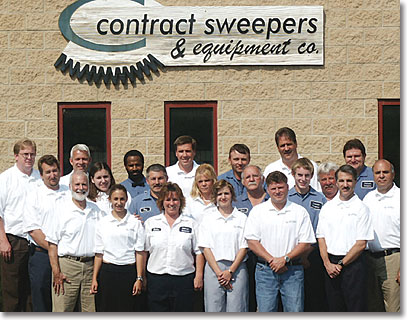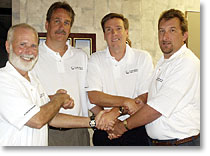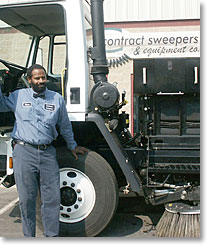These New Employee Owners Say:
"We All Win!"
by Shelley Ross
By listening to Gerry Kesselring talk about his company's recent Employee Stock Ownership Plan sale, you'll hear a man who's enthused about the benefits of the recently completed transaction. Kesselring, who is also the current President of naPSa, is President and CEO of Contract Sweepers & Equipment, an Ohio-based company that employs 100 workers. He's proud to head up this arrangement which both preserves CS&E in its present form and creates an energized, new-ownership mindset among its employees.

CS&E provides industrial and commercial pavement maintenance, warehouse scrubbing and sweeping, industrial power washing and graffiti removal. CS&E also offers sales and service of Advance, Factory Cat and Tymco regenerative air street and parking lot sweepers. The company serves the central and southwestern Ohio area, as well as parts of Indiana and Kentucky.
CS&E was founded in 1960 by Tom Maish, and was recently purchased via an Employee Stock Ownership Plan, a federally-approved program designed to allow eligible employees to share in the ownership of the company. Maish sees this transaction as the best way to reward the hard-working employees who helped grow his company from "one sweeper and two guys" to its current status as one of the largest pavement maintenance companies in the USA. That's a goal he is deeply pleased to have met.
Briefly, it happened like this: CS&E set up the tax-exempt Employee Stock Ownership Plan and hired an outside appraiser to determine the value of the company. The ESOP borrowed money from BankOne in Columbus and, together with contributions from the company in the form of employee retirement funds, the ESOP purchased CS&E from Tom Maish. By making this arrangement as an ESOP and converting the company to a C corporation, taxes are not paid on the sale. Says CEO Kesselring, "The cash stays in your business. This allows you to invest in your people and accomplish more of our common goals."

From L to R: Retiring Founder, Tom Maish; Controller, Bill Miller; CEO and President, Gerry Kesselring; Vice President of Operations, Greg Maish.
|
Gerry Kesselring, and fellow management-team members Bill Miller (VP Finance) and Greg Maish (VP Operations), are in charge of guiding the company's future. Kesselring describes the benefits of the arrangement, and the challenges of implementing it. "Making the employees shareholders is a way that we're rewarding everybody for contributing to the success of this business. Our people have done well with their profit-sharing and 401Ks, but this is the next step, this is the American Dream—I own a business.
"We also added a special benefit, a 'kicker' for a worker's years of service. If two employees earn similar wages but one has been here longer, that individual actually gets a little 'bump' in the allocation of shares. The 30-year man gets a reward for all of those years of loyalty and service."
The management team has set up two committees: a communications committee and a performance-enhancement committee. Kesselring relates that no officers, or even division managers, serve on the committees. "These committees are made up of night operators, mechanics and sales people. These are the people who are asking: How can we make our company better?"

Steve Qualls 22-year veteran
|
Kesselring speaks of teaching people what it means to be an owner, and of leading them to realize their rights, duties and responsibilities to each other and to customers. He wants to inspire them "to take responsibility for their actions every day, in every way."
Kesselring enjoys talking to employees and sharing financial information. Then, he tries to make sure they learn something about it, so they can understand what their business is truly about and how they are a part of it. He knows it will be a long, and sometimes arduous, process. "Others who have been through it tell me: It's not a one-year or a three-year process, but in five years you'll look back and say 'When did it happen?'—because it will happen. And, in the process, we all win."
Shelley Ross is a freelance writer based in the Pacific NW and has been a previous contributor. As far as we can figure out, she is not related to World Sweeper's editor.
How an Employee Stock
Ownership Plan Works
- The owners of a closely-held or family-owned company decide to sell the business to its employees.
- The owners set up a tax-exempt trust account, the Employee Stock Ownership Plan (ESOP), and hire an appraiser to value the entire company.
- The company then borrows money from a bank and reloans it to the ESOP.
- The company pays back the loan with tax deductible contributions from the business' revenue, within certain limits based on payroll.
- The loan, plus the contributions from the business, is used to buy stock from the original owners. Owners get paid as if they had sold the business to another buyer, except that their tax bill on the sale is deferred.
- The stock is allocated into accounts for each employee, usually based on relative pay. It's subject to vesting, as in retirement plans. Employees can sell the stock back to the company when they leave the company or retire.
- Employees, now shareholders, can vote on major transactions like mergers and liquidations. The organizational structure can be more or less democratic depending on how the original owners structured the deal.
Source: The National Center for Employee Ownership
|
This article is reprinted from American Sweeper magazine, Volume 9 Number 2, 2004.
|

